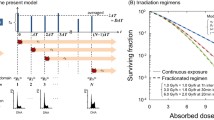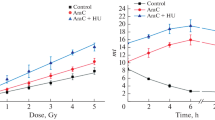Summary
The fixation ofγ-rays induced potentially damage (PLD) caused after treatment either withβ-araA or in medium made hypertonic by the addition of sodium chloride was studied in plateau phase chinese hamster V79 cells. Treatment withβ-araA was found to affect a sector of PLD, the fixation of which specifically reduced the shoulder width of the survival curve. The effect was maximized when cell survival reached levels corresponding to an exponential line, with a slope similar to the final slope of the survival curve of untreated cells. This effect was achieved by a four hour treatment withβ-araA at concentrations above 150µM. Longer treatment times or incubation at higherβ-araA concentrations did not significantly enhance the effect. Treatment in hypertonic medium, on the other hand, enhanced cell killing in a concentration dependent (NaCl-concentration) way and the survival reached values much lower than those corresponding to an exponential line. No indication for a plateau in the effect, indicating complete fixation of the sector of PLD that reacts sensitively to this treatment, was obtained. Both the slope and the shoulder width of the survival curve were affected, the slope first being increased after short treatment times (up to 10 min), followed by a decrease in the shoulder width after longer treatment times (longer than 10 min). Lesions fixed after treatment withβ-araA were repaired within four hours, whereas the repair of lesions fixed after treatment in hypertonic medium (460 mM NaCl, 30 min) appeared to be biphasic, with a fast component (completed in about one hour) correlated with a decrease in the slope and a slow component (completed in four hours) correlated with restoration of the shoulder width. Based on these results, we suggest that two types of PLD may be induced in plateau phase V79 cells after exposure toγ-rays. One, the repair of which is completed within about one hour and which affects the slope of the survival curve, and a second, the repair of which takes place in a few hours and which specifically affects the survival curve shoulder width. The termsβ-PLD andα-PLD are suggested for the first and second component, respectively.
Comparison of the repair rates ofα-PLD as measured with the help ofβ-araA and of sublethal damage as measured in split-dose experiments indicated that these two cellular repair processes have very similar kinetics when measured under the same experimental conditions. Furthermore, the rate was identical at which the shoulder of the survival curve reappeared (shoulder width was the only parameter of the survival curve affected in this type of experiment) in the time interval between either a conditioning dose ofγ-rays and subsequent graded doses or between irradiation and treatment withβ-araA. Based on these results it is suggested thatα-PLD and sublethal damage may have a common molecular base.
Similar content being viewed by others
References
Alper T (1977) Elkind recovery and “sub-lethal damage”: A misleading association. Br J Radiol 50: 459
Belli JA, Dicus GJ, Nagle W (1970) Repair of radiation damage as a factor in preoperative radiation therapy. Front Radiat Ther Oncol 5: 40
Blöcher D, Pohlit W (1982) DNA double strand breaks in Ehrlich ascites tumor cells at low doses of x-ray. II. Can cell death be attributed to double strand breaks? Int J Radiat Biol 42: 329
Bryant PE, Blöcher D (1980) Measurement of the kinetics of DNA double strand breaks repair in Ehrlich ascites tumor cells using the unwinding method. Int J Radiat Biol 38: 335
Busse PM, Bose SK, Jones RW, Tolmach LJ (1971) The action of caffeine on x-irradiated HeLa cells. II. Synergistic lethality. Radiat Res 71: 666
Busse PM, Bose SK, Jones RW, Tolmach LJ (1978) The action of caffeine on x-irradiated HeLa cells. III. Enhancement of x-ray induced killing during G2-arrest. Radiat Res 76: 292
Dicioccio RA, Srivastava BIS (1977) Kinetics of inhibition of deoxynucleotide-polymerizing enzyme activities from normal and leukemic cells by 9-β-D-arabinofuranosyladenine 5-triphosphate and 1-β-D-arabinofuranosylcytosine 5′-triphosphate. Eur J Biochem 79: 411
Douple EB (1975) Recovery following potentially lethal damage in Chinese hamster cells (V-79) in plateau phase cultures and in mouse adenocarcinoma cells (MTG-B) in vitro and in vivo. Radiat Res 62: 552
Dritschilo A, Piro AJ, Frey HE (1976) Repair of radiation damage in plateau phase mammalian cells: Relationship between sublethal and potentially lethal damage sites. Int J Radiat Biol 30: 565
Elkind MM, Whitmore GF (1967) The Radiobiology of cultured mammalian cells. Gordon and Breach, New York London Paris
Frankenberg D, Frankenberg-Schwager M (1981) Interpretation of the shoulder of dose-response curves with immediate plating in terms of repair of potentially lethal lesions during a restricted time period. Int J Radiat Biol 39: 617
Hahn GM, Little JB (1972) Plateau phase cultures of mammalian cells. An in vitro model for human cancer. Curr Top Radiat Res Q8: 39
Hetzel FW, Kruuv J, Frey HE (1976) Repair of potentially lethal damage in x-irradiated V79-cells. Int Radiat Res 68: 308
Horowitz IA, Norwint H, Hall EJ (1975) Conditioned medium from plateau phase cells. Radiology 114: 723
Iliakis G, Pohlit W (1979) Quantitative aspects of repair of potentially lethal damage in mammalian cells. Int J Radiat Biol 36: 649
Iliakis G (1980a) Repair of potentially lethal damage in unfed plateau phase cultures of Ehrlich ascites tumour cells. I. Suspension cultures. Int J Radiat Biol 37: 365
Iliakis G (1980b) Effects ofβ-arabinofuranosyladenine on the growth and repair of potentially lethal damage in Ehrlich ascites tumor cells. Radiat Res 83: 537
Iliakis G (1981) Characterization and properties of repair of potentially lethal damage as measured with the help ofβ-arabinofuranosyladenine in plateau phase EAT cells. Radiat Res 86: 77
Iliakis G, Bryant PE (1983) Effects of nucleoside analoguesα-araA,β-araA, andβ-araC on cell growth and repair of both potentially lethal damage and DNA double strand breaks in mammalian cells in culture. Anticancer Res 3: 143
Iliakis G, Nüsse M (1983a) Evidence that repair and expression of potentially lethal damage cause the variations in cell survival after x-irradiation observed through the cell cycle in Ehrlich ascites tumor cell. Radiat Res 95: 87
Iliakis G, Nüsse M (1983b) The importance of G1/S border and mitosis in the fixation of potentially lethal damage. Radiat Environ Biophys 22: 201
Iliakis G (1984) The influence of conditions affecting repair and fixation of potentially lethal damage on the induction of 6-thioguanine resistance after exposure of mammalian cells to x-rays. Mutat Res 126: 215
Müller WEG, Rhode HJ, Beyer R, Maidhof A, Lachman M, Taschner H, Zahn RD (1975) Mode of action of 9-β-D-arabinofuranosyladenine on the synthesis of DNA, RNA and protein in vivo and in vitro. Cancer Res 85: 2160
Okura A, Yoshida S (1978) Differential inhibition of DNA polymerases of calf thymus by 9-β-D-arabinofuranosyladenine-5′-triphosphate. J Biochem 84: 727
Phillips RA, Tolmach LJ (1966) Repair of potentially lethal damage in x-irradiated HeLa cells. Radiat Res 29: 413
Pohlit W, Heyder IR (1981) The shape of dose-survival curves for mammalian cells and repair of potentially lethal damage analyzed by hypertonic treatment. Radiat Res 87: 613
Raaphorst GP, Dewey WC (1979) Fixation of potentially lethal radiation damage by postirradiation exposure of Chinese hamster cells to 0.05M or 1.5 M NaCl solutions. Int J Radiat Biol 36: 303
Raaphorst GP, Azzam EI (1984) Fixation and repair of radiation damage in normal and ataxia-telangiectasia human cells. Int J Radiat Biol 46: 121–124
Regan JD, Setlow RB (1974) Two forms of repair in the DNA of human cells damaged by chemical carcinogens and mutagens. Cancer Res 34: 3318
Resnick MA, Martin P (1976) The repair of double-strand breaks in the nuclear DNA of Saccharomyces cerevisia and its genetic control. Mol Gen Genet 143: 119
Schroy CB, Todd P (1979) The effects of caffeine on the expression of potentially lethal and sublethal damage inγ-irradiated cultures of mammalian cells. Radiat Res 78: 312
Tolmach LJ, Busse PM (1980) The action of caffeine on x-irradiated HeLa cells. IV. Progression delays and enhanced cell killing at high caffeine concentration. Radiat Res 83: 374
Utsumi H, Elkind MM (1979) Potentially lethal damage versus sublethal damage: Independent repair process in actively growing Chinese hamster cells. Radiat Res 77: 346
Utsumi H, Sasaki MS (1984) Deficient repair of potentially lethal damage in actively growing ataxia telangiectasia cells. Radiat Res 97: 407
Waldren CA, Rasko I (1978) Caffeine enhancement of x-ray killing in cultured human and rodent cells. Radiat Res 73: 95
Whitmore GF, Gulyas S, Kotalik J (1970) Recovery from radiation damage in mammalian cells. In Time and Dose Relationships in Radiation Biology as Applied to Radiotherapy. Report BNL 50203 (C-57), Brookhaven National Laboratory, Upton, NY, pp 41–53
Author information
Authors and Affiliations
Additional information
This work was supported by PHS-grants number CA 33951 and CA 39938 awarded by NCI, DHHS
Rights and permissions
About this article
Cite this article
Iliakis, G. Evidence for the induction of two types of potentially lethal damage after exposure of plateau phase Chinese hamster V79 cells toγ-rays. Radiat Environ Biophys 24, 185–202 (1985). https://doi.org/10.1007/BF01209522
Received:
Accepted:
Issue Date:
DOI: https://doi.org/10.1007/BF01209522




